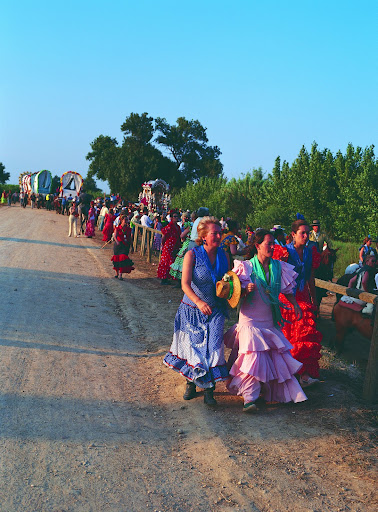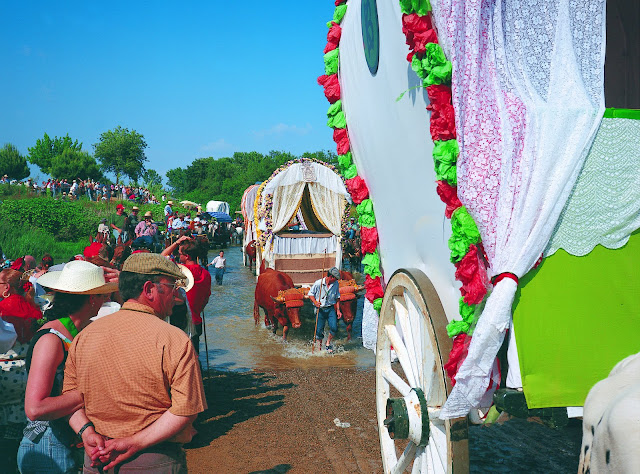When Miguel Coves and Dorothea Darden bought a farm in 2008 in Aiken, South Carolina, their goal was to breed pura raza espanola horses. That’s how horses of “pure Spanish blood” would be available economically to Americans without the need to travel abroad.
The couple owned a breeding and sales business in the small town of Elche before they decided to relocate Coves Darden PRE to Aiken. Dorothea, a native of Lexington, S.C. met her husband Miguel in his native Alicante, Spain.
Now, five years after importing and breeding Spanish horses, Coves and his wife are providing the first American venue for a Romeria a la Virgen del Rocio on their 300-acre farm. The first Romeria, complete with its own hermitage, begins Friday, May 17 and ends Monday, May 20.
The farm boasts bucolic, horse-grazing pastures, lush pine forests, and myriad sycamores. The setting seemed ideal for the construction of a chapel or “ermita” to house an effigy of the “Virgin of El Rocio,” for whom the famous pilgrimage is named.
The Romeria, which describes the annual journey by pilgrims to hear a Mass and visit the site of the holy virgin, takes place annually in El Rocio, a village outside of the town of Almonte in Andalucia in southern Spain.
The hosting an American Romeria inspired the founding of the Costa Este Rociera. The Aiken-based religious organization means East Coast Brotherhood in English. It is similar to brotherhoods that participate in Spain’s annual Holy Week observances. Moreover, CER may be the first of its kind in the United States.
Members of the new South Carolina brotherhood have helped Coves Darden Farm prepare for the anticipated onslaught of devotees from Florida, Georgia, Texas, and other states. In fact, the few hotels in Aiken and nearby Springfield-reserved a year ago-are filled to capacity. Nevertheless, there is still space available for recreational vehicles and campers.
The reason some participants know about Aiken’s Romeria is because they are Spanish citizens who have connected through facebook while residing in the United States. Members of La Casa España social group in Georgia and the Spanish Association of North Florida all talk about the new Romeria via facebook.
“A lot of people don’t know this, but Andalucia is the cradle of Catholicism. So this pilgrimage is a very special time of the year for many Spaniards regardless of where they live,” said Elena Hurst Garcia, a native of Seville who lives in San Antonio, Texas.
Romeria begins each year about 50 days after Holy Week and Seville’s April Fair, Andalucia’s largest outdoor fiesta. South Carolina’s Romeria is also open to the public, in keeping with Spanish hospitality and tradition.
“I took a group of Texas physicians to Holy Week and to El Rocio during Romeria last year, and some of them were so moved by both that they had tears in their eyes,” said Hurst Garcia, who operates a tour guide service to Spain from Texas.
Meanwhile, back in Andalucia, a million Christians and members of more than 100 Andalusian “hermandades” or brotherhoods embark on the Romeria to El Rocio annually. The goal is to arrive in El Rocio on the Saturday before Pentecost Sunday. To that end, preparations take into account that the journey may take up to a week.
Spain’s religious zealots are not the only ones who embark on the weeklong journey. Thousands of tourists from all over Spain and from around the world converge on El Rocio. But not every attendee is there to pray, celebrate Mass, and share their expression of Christian faith.
The main reason for its worldwide popularity may be that it is far from a solemn procession. This is road trip like no other. Romeria is in many ways an adventure featuring sporadic flamenco dancing, drinking, and music at every stop along the route. In fact, many European, Asian, and other tourists don traditional garb in hopes of living the whole experience.

Women wear long, polka dotted ruffled dresses known as traje flamenco paired with knee-high boots. The word flamenco refers to the dresses worn by women who perform the Andalusian art form called Flamenco. The women wear boots in anticipation of river crossings, campouts, and the sandy streets of El Rocio.
During la Romeria, most male counterparts don the traditional short jacket and tight pants. They wear the traditional Cordobes hat, which is black and broad-rimmed. Some men prefer to wear a less traditional hat. Either way, the men are always in full control of heavy, horse or oxen-drawn carriages.
Led by hermandades, devotees or romeros travel on foot, by horseback and oxen-drawn carriages. The colorful canvas-covered carriages shelter pilgrims from the scorching sun. Some carriages are decorated with emblems of the virgin. Others display the emblem of the brotherhood. Modern day pilgrims prefer a more comfortable mode of travel, such as a bus, bike, or car.

According to the official Tourist Office of Spain’s website, there are four roads in Andalucia from which pilgrims generally begin their sojourn to El Rocio regardless of the mode of transportation they choose.
From Sanlúcar, pilgrims cross into Doñana National Park, the most important ecological reserve in Europe. No doubt some pilgrims prefer this route because this is where the Romeria began in the 13th century.
According to the legend, a hunter found a statue of a virgin in a tree. Although he kept it, the statue reappeared in the tree again. The incident was declared a miracle. Consequently, this led to the installation of a virgin christened “La Virgin del Rocio” and the construction of the hermitage at the site.
From Cadiz, pilgrims march along the Los Llanos trail. From Almonte, in the Huelva region of Andalucia, devotees go by way of Moguer, the oldest route. The fourth choice is the route from Seville to El Rocio, which is popular with tourists the world over as well as residents of Seville.
A stark white chapel in El Rocio square holds a statue of the celebrated virgin. Interestingly, the virgin has also been dubbed “la paloma Blanca” or white dove, and “the virgin of the marshes,” for its proximity to the Donana National Park marshlands.

Although the epicenter of the pilgrimage is El Rocio, corral-like homes surrounding the town have their own vibe. Most homes, with large verandahs and hitching posts for horses, are owned by various brotherhoods. The enormous homes are empty all year. But during Romeria, they spill over with devotees.
Before midnight Saturday, all the brotherhoods should have arrived in town. Banners at the ready, they will prepare for the final phase of the Romeria. Reveler and devotee drink, dance and sing until it’s time for the midnight climax.
Shortly after midnight, Almonte’s oldest brotherhood, La Matriz, leads the charge to the chapel. Colloquially speaking, members are said to saltar la reja, which literally means to jump the fence. The fence-jumping is to seize the sheltered virgin and march her through El Rocio’s sandy streets.
On Monday, the festivities start winding down after a Mass and procession around the town. Many who journeyed to El Rocio filled with anticipation are now spent. They dread the long road home but think about returning next year.
Information for this article was obtained from various sources, including the websites of the people and organizations mentioned.
For information on participating in the Romeria in South Carolina, and reserving a space for an RV or camping, contact www.costaesterociera.com
Coves Darden Farm PRE is at: www.covesdarden.com
For information on visiting Spain go to www.spain.info.com
Information on Andalucia is at www.andalucia.org
Rosie Carbo is the Lifestyles Editor for Wandering Educators,
and is a former newspaper reporter whose work has appeared in newspapers
and magazines nationwide. Some of those publications include People
magazine, The Dallas Morning News, The Houston Chronicle and San Antonio
Express-News. Some of her features were redistributed by The Associated
Press early in her career as an award-winning Texas journalist.
